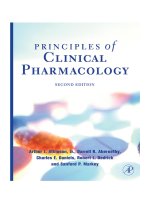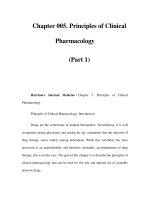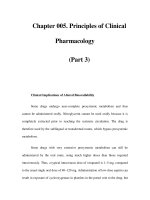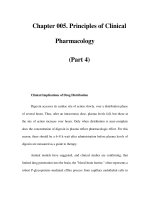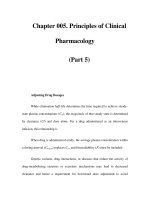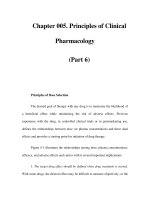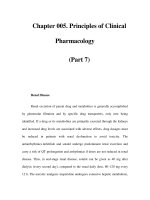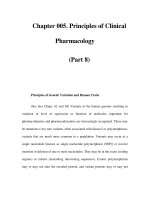Chapter 005. Principles of Clinical Pharmacology (Part 12) doc
Bạn đang xem bản rút gọn của tài liệu. Xem và tải ngay bản đầy đủ của tài liệu tại đây (13.14 KB, 5 trang )
Chapter 005. Principles of Clinical
Pharmacology
(Part 12)
Drug Interactions Not Mediated by Changes in Drug Disposition
Drugs may act on separate components of a common process to generate
effects greater than either has alone. Antithrombotic therapy with combinations of
antiplatelet agents (glycoprotein IIb/IIIa inhibitors, aspirin, clopidogrel) and
anticoagulants (warfarin, heparins) are often used in the treatment of vascular
disease, although such combinations carry an increased risk of bleeding.
Nonsteroidal anti-inflammatory drugs (NSAIDs) cause gastric ulcers, and
in patients treated with warfarin, the risk of bleeding from a peptic ulcer is
increased almost threefold by concomitant use of an NSAID.
Indomethacin, piroxicam, and probably other NSAIDs antagonize the
antihypertensive effects of -adrenergic receptor blockers, diuretics, ACE
inhibitors, and other drugs. The resulting elevation in blood pressure ranges from
trivial to severe. This effect is not seen with aspirin and sulindac but has been
found with the cyclooxygenase 2 (COX-2) inhibitor celecoxib.
Torsades des pointes during administration of QT-prolonging
antiarrhythmics (quinidine, sotalol, dofetilide) occur much more frequently in
patients receiving diuretics, probably reflecting hypokalemia. In vitro,
hypokalemia not only prolongs the QT interval in the absence of drug but also
potentiates drug block of ion channels that results in QT prolongation. Also, some
diuretics have direct electrophysiologic actions that prolong QT.
The administration of supplemental potassium leads to more frequent and
more severe hyperkalemia when potassium elimination is reduced by concurrent
treatment with ACE inhibitors, spironolactone, amiloride, or triamterene.
The pharmacologic effects of sildenafil result from inhibition of the
phosphodiesterase type 5 isoform that inactivates cyclic GMP in the vasculature.
Nitroglycerin and related nitrates used to treat angina produce vasodilation by
elevating cyclic GMP. Thus, coadministration of these nitrates with sildenafil can
cause profound hypotension, which can be catastrophic in patients with coronary
disease.
Sometimes, combining drugs can increase overall efficacy and/or reduce
drug-specific toxicity. Such therapeutically useful interactions are described in
chapters dealing with specific disease entities, elsewhere in this text.
Adverse Reactions to Drugs
The beneficial effects of drugs are coupled with the inescapable risk of
untoward effects. The morbidity and mortality from these untoward effects often
present diagnostic problems because they can involve every organ and system of
the body; these may be mistaken for signs of underlying disease.
Adverse reactions can be classified in two broad groups. One type results
from exaggeration of an intended pharmacologic action of the drug, such as
increased bleeding with anticoagulants or bone marrow suppression with
antineoplastics. The other type of adverse reactions ensues from toxic effects
unrelated to the intended pharmacologic actions. The latter effects are often
unanticipated (especially with new drugs) and frequently severe and result from
recognized as well as undiscovered mechanisms.
Drugs may increase the frequency of an event that is common in a general
population, and this may be especially difficult to recognize; the increase in
myocardial infarctions with the COX-2 inhibitor rofecoxib is an excellent
example. Drugs can also cause rare and serious adverse effects, such as
hematologic abnormalities, arrhythmias, or hepatic or renal dysfunction. Prior to
regulatory approval and marketing, new drugs are tested in relatively few patients
who tend to be less sick and to have fewer concomitant diseases than those
patients who subsequently receive the drug therapeutically. Because of the
relatively small number of patients studied in clinical trials and the selected nature
of these patients, rare adverse effects are generally not detected prior to a drug's
approval, and physicians therefore need to be cautious in the prescription of new
drugs and alert for the appearance of previously unrecognized adverse events.
Elucidating mechanisms underlying adverse drug effects can assist
development of safer compounds or allow a patient subset at especially high risk
to be excluded from drug exposure. National adverse reaction reporting systems,
such as those operated by the FDA (suspected adverse reactions can be reported
online at and the Committee on
Safety of Medicines in Great Britain, can prove useful. The publication or
reporting of a newly recognized adverse reaction can in a short time stimulate
many similar such reports of reactions that previously had gone unrecognized.
Occasionally, "adverse" effects may be exploited to develop an entirely
new indication for a drug. Unwanted hair growth during minoxidil treatment of
severely hypertensive patients led to development of the drug for hair growth.
Sildenafil was initially developed as an antianginal, but its effects to alleviate
erectile dysfunction not only led to a new drug indication but also to increased
understanding of the role of type 5 phosphodiesterase in erectile tissue. These
examples further reinforce the concept that prescribers must remain vigilant to the
possibility that unusual symptoms may reflect unappreciated drug effects.
Some 25–50% of patients make errors in self-administration of prescribed
medicines, and these errors can be responsible for adverse drug effects. Similarly,
patients commit errors in taking OTC drugs by not reading or following the
directions on the containers. Physicians must recognize that providing directions
with prescriptions does not always guarantee compliance.
In hospital, drugs are administered in a controlled setting, and patient
compliance is, in general, ensured. Errors may occur nevertheless—the wrong
drug or dose may be given or the drug may be given to the wrong patient—and
improved drug distribution and administration systems are addressing this
problem.
